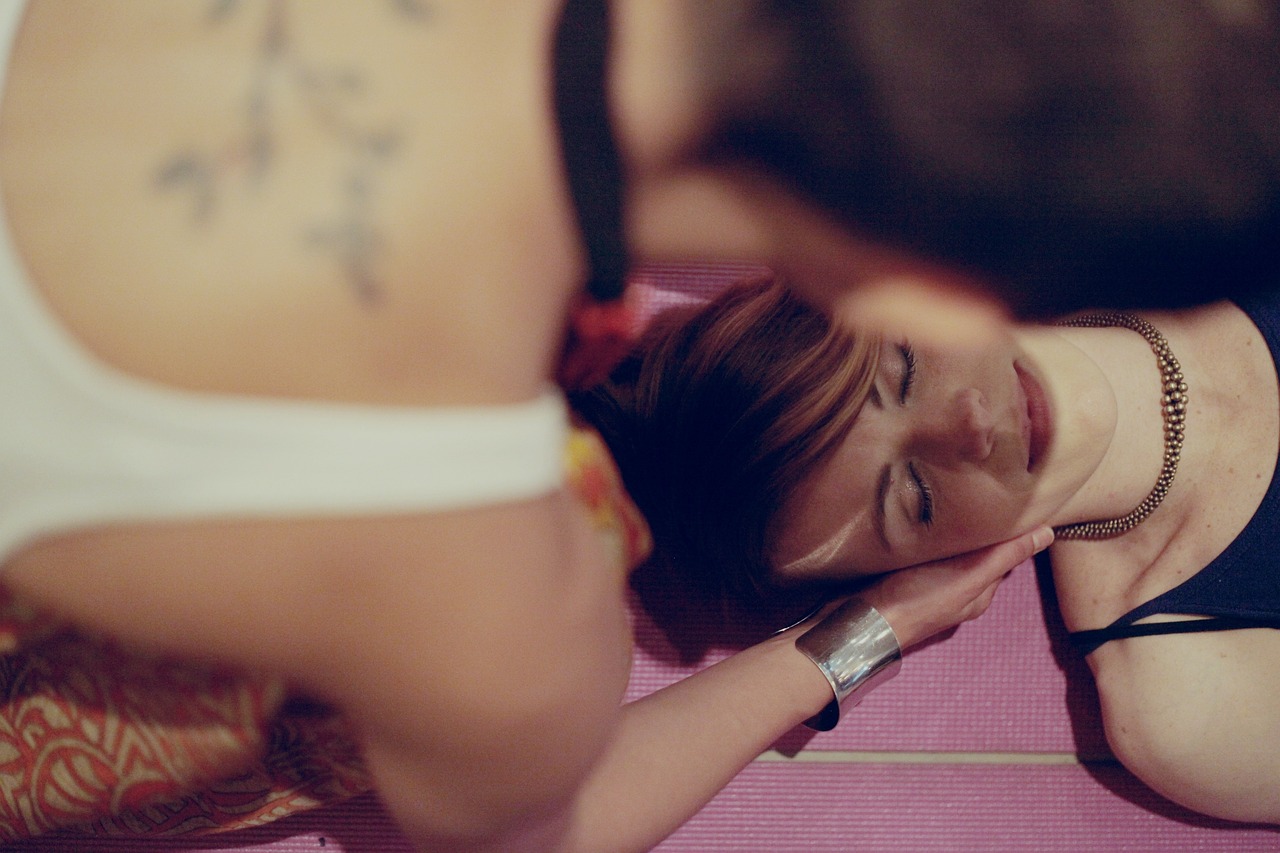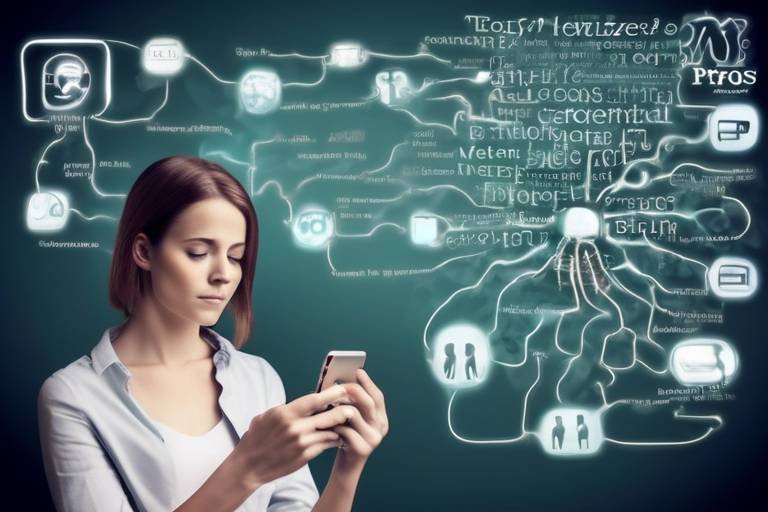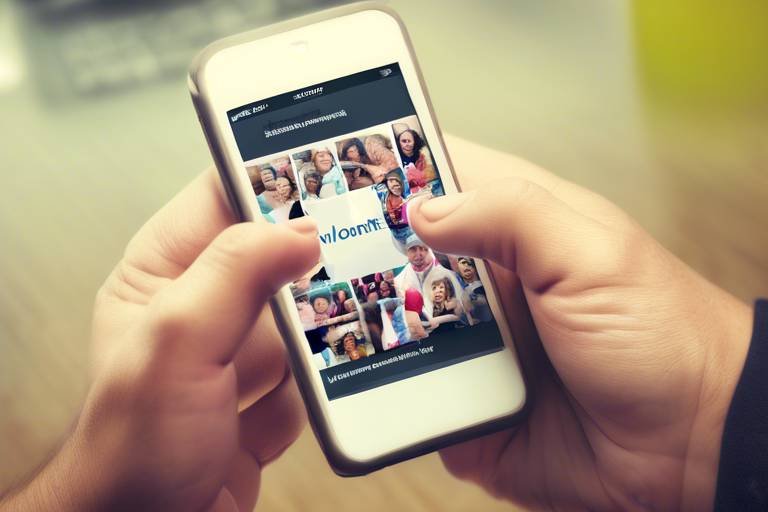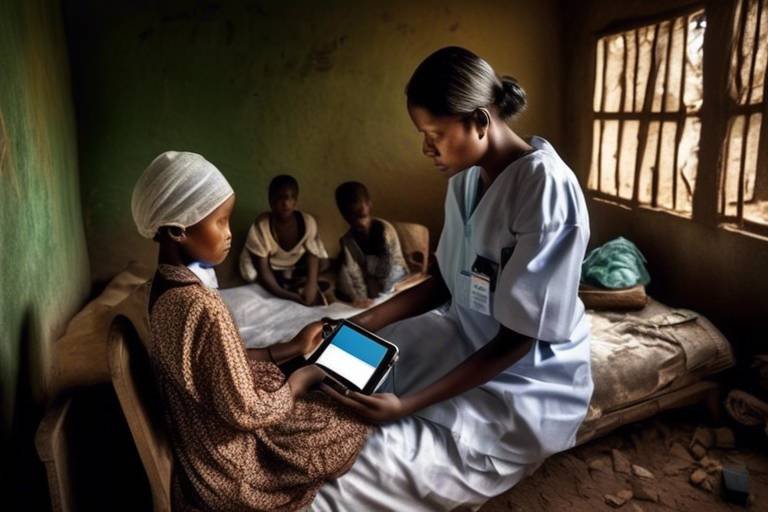Technology and Mental Health - The Pros and Cons
The relationship between technology and mental health is a complex tapestry woven with both bright and dark threads. As we navigate through the digital age, we find ourselves standing at a crossroads where technology can either uplift our mental well-being or lead us down a path of distress. It's a bit like having a double-edged sword; one side can be a beacon of hope, while the other can cut deep into our emotional fabric. In this article, we will explore the multifaceted impacts of technology on mental health, examining both its positive and negative effects. So, grab a cup of coffee, settle in, and let’s dive into this intriguing topic!
When we think of technology, we often envision the latest gadgets and apps. However, its role in enhancing mental health is equally significant. One of the most remarkable benefits is the access to resources. With just a few clicks, individuals can find a wealth of information about mental health conditions, coping strategies, and self-help techniques. This accessibility can empower people to take charge of their mental well-being, much like having a personal therapist available 24/7.
Moreover, technology has fostered the creation of support networks. Online communities, forums, and social media groups allow individuals to connect with others who share similar experiences. This sense of belonging can be incredibly therapeutic, reminding us that we are not alone in our struggles. Additionally, various therapeutic tools, such as mindfulness apps and virtual therapy platforms, provide innovative ways to enhance emotional well-being and promote recovery. These tools can be as effective as traditional methods, offering flexibility and convenience that cater to our fast-paced lives.
While technology can be a powerful ally, it also has a darker side that we cannot ignore. One of the most pressing issues is the risk of addiction. Just like a moth drawn to a flame, many individuals find themselves glued to their screens, leading to a cycle of dependency that can exacerbate feelings of loneliness and anxiety. The constant need to check notifications or scroll through feeds can create a sense of urgency that leaves little room for genuine human interaction.
Social isolation is another significant concern. Although technology connects us, it can also create a false sense of intimacy. People may find themselves engaging more with their devices than with the people around them, leading to a profound sense of disconnection. This paradox is particularly evident in the realm of social media, where individuals often compare their lives to the curated highlights of others, resulting in lowered self-esteem and increased anxiety.
Social media is a double-edged sword in the mental health arena. On one hand, it can connect and isolate individuals simultaneously. The pressure to maintain an idealized online presence can be overwhelming, leading to feelings of inadequacy and anxiety. It’s like attending a party where everyone seems to be having a great time, while you’re stuck in the corner feeling out of place.
One of the most alarming aspects of social media is cyberbullying. This modern-day menace has become a prevalent issue, leading to severe emotional distress and mental health challenges for victims. The anonymity of the internet can embolden bullies, making it easier for them to inflict harm without facing immediate consequences. Victims often experience feelings of helplessness and despair, highlighting the urgent need for awareness and preventive measures.
On the flip side, social media can also foster supportive communities. Many individuals have found solace in online groups where they can share their experiences and seek help. These platforms can serve as lifelines for those struggling with mental health issues, offering a space to voice their concerns and connect with others who understand their journey. It’s like finding a group of friends who get you, even if they’re miles away.
Another significant advancement in mental health care is teletherapy. This revolutionary approach provides convenient access to professional help, breaking down barriers that may prevent individuals from seeking traditional therapy. Whether it’s due to geographical limitations, scheduling conflicts, or stigma, teletherapy offers a flexible alternative that can significantly enhance mental health support. It’s as if therapy has been brought right to your living room, making it easier than ever to prioritize your mental well-being.
However, it’s essential to recognize that excessive technology use can lead to heightened anxiety levels. The constant barrage of notifications and digital interactions can contribute to feelings of stress and overwhelm. It’s like trying to juggle too many balls at once; eventually, something is bound to drop.
Increased screen time, particularly before bed, can disrupt sleep patterns, negatively impacting mental health and overall well-being. The blue light emitted by screens can interfere with the body’s natural sleep cycle, leading to insomnia and fatigue. This sleep deprivation can create a vicious cycle, where poor sleep exacerbates anxiety and stress.
To combat these negative effects, it’s crucial to implement boundaries and mindful practices. Consider setting specific times to unplug from devices, engaging in activities that promote mental well-being, such as reading, exercising, or spending quality time with loved ones. By fostering a healthier relationship with technology, we can mitigate its adverse effects and harness its potential for good.
- How can technology improve mental health? Technology can provide access to resources, support networks, and therapeutic tools that enhance emotional well-being.
- What are the negative effects of technology on mental health? Negative effects include addiction, social isolation, and increased anxiety levels.
- Is social media good or bad for mental health? Social media has both positive and negative impacts, offering support but also leading to comparison and cyberbullying.
- What is teletherapy? Teletherapy is a convenient way to access mental health support through online platforms, making therapy more accessible.

Positive Impacts of Technology on Mental Health
Technology has become an integral part of our daily lives, and its influence on mental health is both profound and multifaceted. One of the most significant benefits is the access to resources. With just a few clicks, individuals can find a wealth of information about mental health issues, coping strategies, and self-help techniques. This accessibility empowers people to take charge of their well-being, allowing them to educate themselves on topics that were once shrouded in stigma.
Moreover, technology has given rise to support networks that transcend geographical boundaries. Online forums, social media groups, and dedicated mental health apps provide spaces where individuals can connect with others who share similar experiences. Imagine being able to chat with someone halfway across the world who understands your struggles! These platforms foster a sense of community and belonging, which is essential for emotional well-being.
In addition to support networks, technology offers innovative therapeutic tools that can enhance emotional resilience. For instance, numerous apps are designed to help users practice mindfulness, track their moods, and even engage in cognitive-behavioral therapy (CBT) exercises. These tools are not just convenient; they can also be a game-changer for individuals who may find traditional therapy intimidating or inaccessible. The ability to work on one’s mental health from the comfort of home can be incredibly liberating.
Teletherapy, or online therapy, has also emerged as a vital resource, especially during times of crisis, such as the recent global pandemic. With teletherapy, individuals can connect with licensed professionals through video calls, phone calls, or even text messaging. This flexibility is particularly beneficial for those who live in remote areas or have mobility issues. It removes barriers to access, making mental health care more inclusive than ever before.
Furthermore, technology can facilitate improved communication between individuals and their mental health providers. Secure messaging systems allow patients to reach out to their therapists or counselors between sessions, enabling them to share thoughts or concerns that arise in real-time. This ongoing dialogue can enhance the therapeutic relationship and lead to better outcomes.
In summary, while technology has its downsides, the positive impacts on mental health are undeniable. From providing access to valuable resources and support networks to offering innovative therapeutic tools and teletherapy options, technology plays a crucial role in promoting emotional well-being. As we continue to navigate the digital age, it’s essential to harness these benefits while remaining mindful of the potential pitfalls.
- How can I find reliable mental health resources online? Look for reputable websites such as those run by mental health organizations or government health departments. Always check the credentials of the authors or organizations providing the information.
- What are some popular mental health apps? Some widely used apps include Headspace for mindfulness, Moodfit for mood tracking, and BetterHelp for teletherapy services.
- Is teletherapy as effective as in-person therapy? Research suggests that teletherapy can be just as effective as traditional therapy for many individuals, particularly when it comes to convenience and accessibility.

Negative Impacts of Technology on Mental Health
While technology has undeniably transformed our lives in many positive ways, it also comes with a darker side that can significantly impact our mental health. The constant connectivity that technology provides can sometimes feel like a double-edged sword. On one hand, it keeps us linked to friends and family; on the other, it can lead to feelings of isolation and anxiety. For instance, the pressure to be always "on" can create a sense of obligation that weighs heavily on our minds. Isn't it ironic that while we are more connected than ever, many of us feel more alone?
One of the most pressing concerns is the issue of addiction. Just like a moth drawn to a flame, individuals often find themselves glued to their screens, scrolling through social media feeds or binge-watching shows late into the night. This compulsive behavior can lead to a host of mental health issues, including anxiety and depression. The constant barrage of notifications can create a sense of urgency that keeps our minds racing, making it difficult to relax and unwind. According to recent studies, a significant percentage of people report feeling anxious when they are unable to access their devices. It's a troubling trend that raises the question: are we losing control over our own lives?
Moreover, the rise of social media has introduced a new layer of complexity to our mental health landscape. Platforms designed for connection can inadvertently foster feelings of inadequacy and low self-esteem. When we scroll through curated images of others' seemingly perfect lives, it's easy to fall into the trap of comparison. This can lead to a distorted self-image and feelings of worthlessness. The pressure to maintain an idealized online persona can be overwhelming, causing individuals to sacrifice their authenticity for likes and followers. The irony here is palpable: in our quest for validation, we may end up feeling more isolated than ever.
Cyberbullying is another alarming consequence of our digital age. With the anonymity that the internet provides, individuals may feel emboldened to engage in harmful behaviors that they would likely avoid in face-to-face interactions. Victims of cyberbullying often experience severe emotional distress, leading to anxiety, depression, and even suicidal thoughts. It's a sobering reminder that our online interactions can have real-world consequences. The need for awareness and preventive measures has never been more crucial. Schools and communities must work together to create safe online environments, ensuring that individuals feel supported rather than attacked.
Yet, it's important to recognize that not all social media interactions are negative. There are also positive connections that can emerge from these platforms. Many people find solace in online communities where they can share their experiences and seek support. However, the challenge lies in distinguishing between healthy engagement and harmful consumption. How do we strike that balance? It requires self-awareness and a willingness to step back and evaluate our online habits.
While discussing the negative impacts of technology, we must also acknowledge the silver linings. Teletherapy has emerged as a beacon of hope for many individuals seeking mental health support. The convenience of accessing a therapist from the comfort of your home can remove barriers that previously prevented people from seeking help. For those living in remote areas or facing mobility challenges, teletherapy can be a game-changer. It’s a reminder that technology, when used mindfully, can also serve as a tool for healing.
In conclusion, while technology can enhance our lives in numerous ways, it is essential to remain vigilant about its potential negative impacts on mental health. By fostering awareness and encouraging healthy technology use, we can navigate this complex landscape and promote better mental well-being for ourselves and others.
- Can technology really affect my mental health?
Yes, excessive use of technology can lead to issues like anxiety, depression, and social isolation. - What are some signs of technology addiction?
Signs include neglecting responsibilities, feeling anxious when unable to use devices, and experiencing withdrawal symptoms. - How can I use technology positively?
Set boundaries for screen time, engage in supportive online communities, and utilize teletherapy options when needed. - Is social media harmful to mental health?
It can be, especially if it leads to comparison or cyberbullying, but it can also foster support and connection.

Social Media and Mental Health
In today’s digital age, social media has become an integral part of our lives, acting as a double-edged sword when it comes to mental health. On one hand, it provides a platform for connection, allowing individuals to share their experiences, seek support, and find communities that resonate with their struggles. However, on the other hand, it can lead to feelings of isolation and inadequacy. Have you ever scrolled through your feed and felt a twinge of envy or self-doubt? This is the paradox of social media: it can either uplift us or drag us down.
One of the most significant ways social media impacts mental health is through the phenomenon of comparison. Users often find themselves comparing their lives to the curated, often unrealistic portrayals of others. This can lead to a decline in self-esteem and increased anxiety. For instance, studies have shown that individuals who spend more time on platforms like Instagram report higher levels of dissatisfaction with their own lives. It’s as if we are constantly measuring ourselves against an ideal that is not only unattainable but also often fabricated.
Moreover, the rise of cyberbullying on these platforms has introduced a new layer of emotional distress. Victims of cyberbullying may experience severe mental health challenges, including depression and anxiety. The anonymity of the internet can embolden bullies, making it easier for them to target individuals without facing immediate consequences. This type of harassment can leave lasting scars, emphasizing the need for awareness and preventive measures in our digital interactions.
However, it is essential to recognize that social media isn’t all doom and gloom. It can also serve as a lifeline for many. For those grappling with mental health issues, finding others who share similar experiences can be incredibly validating. Support groups and communities on platforms like Facebook or Reddit offer a space where individuals can share their stories, coping strategies, and encouragement. This sense of belonging can significantly enhance emotional well-being, proving that social media can also be a powerful tool for healing.
To strike a balance, it’s crucial for users to engage with social media mindfully. Here are some strategies to consider:
- Limit time spent on social media to reduce exposure to negative content.
- Curate your feed by following accounts that promote positivity and mental wellness.
- Engage in real-life interactions to complement online connections.
In conclusion, the relationship between social media and mental health is complex and multifaceted. While it has the potential to foster connection and support, it also harbors risks that can lead to emotional distress. By being aware of these dynamics and implementing mindful practices, individuals can navigate the social media landscape in a way that enhances their mental well-being rather than detracts from it.
Q1: Can social media really affect my mental health?
A1: Yes, social media can have both positive and negative effects on mental health. It can foster connections and support, but it can also lead to feelings of inadequacy and anxiety due to comparison and cyberbullying.
Q2: How can I use social media in a healthier way?
A2: Consider limiting your time on social media, following positive accounts, and engaging more in real-life interactions. Being mindful of your social media use can help mitigate its negative impacts.
Q3: What should I do if I experience cyberbullying?
A3: It's important to report the behavior on the platform, block the bully, and seek support from friends, family, or a mental health professional. Remember, you are not alone, and there are resources available to help you.

Cyberbullying and Its Effects
Cyberbullying has emerged as a significant issue in our increasingly digital world, affecting countless individuals, particularly the youth. Imagine walking into a room filled with people, but instead of feeling welcomed, you feel like you're under a spotlight, with everyone judging you. This is akin to what victims of cyberbullying experience every day, as they navigate the harsh realities of online harassment. The anonymity and distance provided by the internet can embolden bullies, allowing them to target their victims without facing immediate consequences.
The effects of cyberbullying can be devastating and far-reaching. Victims often experience a range of emotional responses, including anxiety, depression, and feelings of isolation. The constant barrage of negative messages can lead to a decline in self-esteem, making individuals feel worthless and alone. In severe cases, the emotional distress caused by cyberbullying can lead to thoughts of self-harm or even suicide. According to recent studies, victims of cyberbullying are at a significantly higher risk of developing mental health disorders compared to their peers who are not targeted.
One of the most troubling aspects of cyberbullying is its pervasive nature. Unlike traditional bullying, which may be confined to school grounds or specific social circles, cyberbullying can follow victims into their homes, creating a sense of inescapability. The digital footprint left by bullies can linger indefinitely, with hurtful messages, images, or videos remaining accessible online. This can lead to a cycle of victimization that feels relentless and overwhelming.
Moreover, the impact of cyberbullying doesn't just affect the victims; it can also have repercussions for bystanders and the bullies themselves. Bystanders who witness cyberbullying often feel powerless, leading to feelings of guilt or anxiety about their inability to intervene. On the other hand, those who engage in cyberbullying may also face consequences, including social ostracism, legal repercussions, and their own mental health struggles.
To combat cyberbullying, it's crucial for individuals, parents, and educators to be proactive. Awareness is the first step; understanding the signs of cyberbullying can help in identifying victims and bullies. Open conversations about online behavior and its consequences can foster a more supportive environment. Schools and communities can implement programs that educate students about empathy, respect, and the importance of standing up against bullying.
In conclusion, the effects of cyberbullying are profound and multifaceted, impacting not only the victims but also the broader community. As we continue to navigate the complexities of technology, we must prioritize mental health and create a culture of kindness and support in both online and offline spaces.
- What is cyberbullying? Cyberbullying involves using digital platforms to harass, threaten, or humiliate someone. It can take various forms, including sending hurtful messages, spreading rumors, or sharing embarrassing photos.
- Who is most affected by cyberbullying? While anyone can be a target, children and teenagers are particularly vulnerable due to their increased use of social media and online communication.
- What can I do if I or someone I know is being cyberbullied? It's essential to report the behavior to the platform, seek support from trusted individuals, and document any evidence of the bullying.
- How can parents help prevent cyberbullying? Parents can educate their children about safe online practices, encourage open communication, and monitor their online activity to help prevent bullying.

Positive Connections through Social Media
In a world where we often feel disconnected, social media can serve as a lifeline, providing a platform for individuals to forge meaningful connections. Imagine being able to reach out and find someone who understands exactly what you're going through, no matter where they are in the world. This is the magic of social media! It allows people to create communities that transcend geographical barriers, bringing together individuals with shared experiences and challenges. For many, these online spaces become a sanctuary where they can express their thoughts and feelings without judgment.
One of the most significant advantages of social media is its ability to foster supportive networks. Whether it’s through dedicated groups for mental health, hobbies, or specific life challenges, these platforms provide a sense of belonging. Here’s how social media can positively impact mental health:
- Access to Resources: Users can share articles, videos, and personal stories that offer valuable insights and coping strategies.
- Peer Support: Individuals can connect with others facing similar struggles, providing emotional support and encouragement.
- Awareness and Advocacy: Social media campaigns can raise awareness about mental health issues, reducing stigma and encouraging open conversations.
Moreover, social media can serve as a powerful tool for self-expression. People often share their journeys, triumphs, and setbacks, which can resonate with others and remind them that they are not alone. This sharing can lead to a sense of validation and understanding, essential components for anyone grappling with mental health challenges. For instance, when someone posts about their anxiety or depression, the outpouring of support can be both uplifting and affirming.
However, it’s essential to approach social media mindfully. While it can be a source of positivity, it’s crucial to curate your feed to include accounts that inspire and uplift you. Following accounts that promote mental health awareness, positivity, and self-care can help create a more supportive online environment. In contrast, engaging with negative or toxic content can have the opposite effect, leading to feelings of inadequacy and isolation.
In conclusion, while social media has its pitfalls, it undeniably offers a platform for positive connections that can significantly enhance mental health. By leveraging these tools wisely, individuals can build supportive communities that foster resilience and emotional well-being. Just like any tool, the impact of social media ultimately depends on how we choose to use it.
- Can social media really help with mental health? Yes, when used mindfully, social media can provide support, resources, and a sense of community for those struggling with mental health issues.
- How can I ensure my social media use is positive? Curate your feed by following accounts that promote positivity, mental health awareness, and self-care, while unfollowing accounts that negatively impact your mood.
- What should I do if I encounter cyberbullying on social media? Report the behavior to the platform, block the individual, and seek support from friends or mental health professionals if needed.

Teletherapy and Online Support
In today's fast-paced digital world, teletherapy has emerged as a game-changer for mental health treatment. Imagine being able to connect with a qualified therapist from the comfort of your own home, without the stress of commuting or the anxiety of sitting in a waiting room. This convenience is one of the many reasons why teletherapy has gained popularity. With just a few clicks, individuals can access a wealth of mental health resources that were once limited by geographical barriers.
Teletherapy not only provides immediate access to professional help, but it also offers a variety of formats to suit different preferences. Whether through video calls, phone sessions, or even text-based therapy, individuals can choose the method that feels most comfortable for them. This flexibility is particularly beneficial for those who may have busy schedules or face challenges in attending traditional therapy sessions.
Moreover, online support groups have flourished alongside teletherapy, creating virtual communities where individuals can share their experiences and offer mutual support. These platforms can be a lifeline for those feeling isolated or misunderstood. For instance, individuals struggling with anxiety or depression can find solace in knowing that they are not alone in their struggles. The power of connection, even through a screen, can significantly enhance emotional well-being.
However, it's essential to recognize that teletherapy is not without its challenges. Some individuals may feel discomfort with technology or struggle to express themselves in a virtual setting. Additionally, the effectiveness of teletherapy can vary depending on the individual's specific needs and the nature of their mental health concerns. It’s crucial to find a therapist who is not only qualified but also adept at navigating the online space.
To ensure a successful teletherapy experience, consider the following tips:
- Choose the Right Platform: Ensure that the teletherapy platform is secure and user-friendly.
- Establish a Comfortable Environment: Find a quiet, private space where you can focus on your session without distractions.
- Communicate Openly: Be honest with your therapist about your feelings and any challenges you face during the session.
In summary, teletherapy and online support offer a modern solution to mental health challenges, breaking down barriers and providing essential resources for those in need. As we continue to embrace technology in our daily lives, the potential for enhanced mental health care through these digital avenues is both exciting and promising.
Q: What is teletherapy?
A: Teletherapy refers to therapy sessions conducted via digital platforms such as video calls, phone calls, or messaging apps, allowing individuals to connect with therapists remotely.
Q: Is teletherapy as effective as in-person therapy?
A: Research suggests that teletherapy can be just as effective as traditional in-person therapy for many individuals, although effectiveness may vary based on personal preferences and specific mental health needs.
Q: What do I need for teletherapy?
A: To participate in teletherapy, you typically need a device with internet access (like a computer, tablet, or smartphone), a quiet space for your sessions, and a reliable teletherapy platform.
Q: Can teletherapy help with severe mental health issues?
A: Teletherapy can be beneficial for various mental health concerns, but individuals with severe issues should consult with their healthcare provider to determine the best course of action.

Technology Use and Anxiety
In today’s fast-paced digital world, technology has become an integral part of our daily lives. While it offers countless conveniences, it also brings along a hidden burden: anxiety. Have you ever felt that rush of panic when your phone buzzes with notifications, or when you realize you’ve spent hours scrolling through social media? You're not alone. Many individuals experience heightened anxiety levels due to excessive technology use.
The constant influx of information can be overwhelming. We are bombarded with notifications from various apps—emails, social media updates, and news alerts—creating a sense of urgency that can lead to stress. This phenomenon is often referred to as “notification fatigue.” It’s like being in a crowded room where everyone is shouting for your attention. How can you focus on what truly matters when distractions are constantly pulling you in different directions?
Moreover, the pressure to stay connected and respond instantly can lead to a fear of missing out (FOMO), amplifying feelings of anxiety. The more we engage with technology, the more we may feel the need to be “on” all the time. This can create a vicious cycle where our mental health deteriorates as we chase the elusive goal of being perfectly connected. In fact, studies have shown that individuals who spend excessive time on social media platforms often report higher levels of anxiety and depression.
One of the critical aspects contributing to anxiety is the impact of screen time on our mental state. Research indicates that prolonged screen time, especially before bed, can disrupt our natural sleep patterns. Lack of sleep can exacerbate feelings of anxiety, creating a feedback loop that is hard to break. Picture this: you’re lying in bed, scrolling through your phone, and the blue light emitted from the screen tricks your brain into thinking it’s still daytime. As a result, you struggle to fall asleep, leading to fatigue and heightened anxiety the next day. It’s a cycle that can feel inescapable.
To combat these issues, it’s essential to establish healthy boundaries around technology use. Here are some strategies that can help:
- Set specific times for technology use: Designate certain hours for checking emails or social media to prevent constant distractions.
- Limit screen time before bed: Aim to put away devices at least an hour before sleep to improve your sleep quality.
- Practice mindfulness: Engage in mindfulness exercises or meditation to help ground yourself and reduce anxiety levels.
By implementing these practices, you can cultivate a healthier relationship with technology, ultimately reducing anxiety and improving your overall mental well-being. Remember, technology should serve you, not control you. It’s all about finding that balance that allows you to enjoy the benefits of digital advancements while protecting your mental health.
Q: How does technology use lead to anxiety?
A: Technology use can lead to anxiety through constant notifications, the pressure to stay connected, and the impact of excessive screen time on sleep patterns.
Q: What are some signs of technology-related anxiety?
A: Signs can include feeling overwhelmed by notifications, experiencing FOMO, difficulty concentrating, and disrupted sleep patterns.
Q: How can I reduce anxiety related to technology use?
A: You can reduce anxiety by setting boundaries for technology use, limiting screen time before bed, and practicing mindfulness techniques.

Screen Time and Sleep Disruption
In today's fast-paced digital world, it's hard to escape the glow of our screens. Whether we're scrolling through social media, binge-watching our favorite shows, or catching up on work emails, screen time has become a staple of our daily lives. But have you ever considered how this constant exposure to screens affects your sleep? The truth is, excessive screen time—especially before bed—can wreak havoc on our sleep patterns, leading to a cascade of mental health issues.
Research has shown that the blue light emitted by screens can interfere with the production of melatonin, the hormone responsible for regulating sleep. When we expose ourselves to this blue light late at night, our bodies can get tricked into thinking it's still daytime, making it harder to fall asleep. This disruption can result in a vicious cycle; the less sleep we get, the more our mental health suffers, which may lead us to seek comfort in technology, further exacerbating the problem.
Moreover, the content we consume during our screen time can also play a role in our sleep quality. Engaging with stressful or stimulating material—like intense news stories or competitive video games—can keep our minds racing long after we put down our devices. It's as if our brains are in a constant state of alertness, making it nearly impossible to wind down. So, how can we combat this issue? Here are a few strategies:
- Establish a Digital Curfew: Set a specific time each evening to turn off all screens. This allows your mind to relax and prepare for sleep.
- Engage in Screen-Free Activities: Consider reading a book, practicing meditation, or even journaling to help you unwind.
- Use Blue Light Filters: Many devices now come with settings to reduce blue light exposure. Utilize these features, especially in the evening.
It's essential to recognize that our relationship with technology doesn't have to be detrimental. By being mindful of our screen time and its impact on our sleep, we can foster a healthier balance that promotes better mental health. Remember, good sleep is not just a luxury—it’s a necessity for our overall well-being. So, the next time you find yourself mindlessly scrolling through your phone at midnight, consider the toll it may take on your mental health and make a conscious effort to put it down.
Q: How does screen time affect sleep quality?
A: Excessive screen time, particularly before bed, can disrupt melatonin production due to blue light exposure, leading to difficulty falling asleep and poorer sleep quality.
Q: What are some alternatives to screen time before bed?
A: Consider engaging in relaxing activities such as reading a physical book, meditating, or practicing gentle yoga to help prepare your mind for sleep.
Q: How can I manage my screen time effectively?
A: Setting a digital curfew, using apps to track your screen time, and taking regular breaks can help you manage your technology use and promote healthier habits.

Strategies for Healthy Technology Use
In today's fast-paced digital world, finding a balance in technology use is essential for maintaining mental health. While technology has its perks, it's easy to get swept up in the endless notifications, social media scrolls, and binge-watching marathons. So, how can we create a healthier relationship with our devices? Here are some strategies that might help you reclaim your time and peace of mind.
First, consider setting boundaries around your technology use. This could mean designating specific times of the day when you check your emails or social media accounts. For example, you might decide to unplug for an hour before bedtime to help your mind unwind. Think of it like a digital detox; just as you would cleanse your body, you can cleanse your mind from the constant barrage of information. It’s all about creating a structure that allows you to enjoy technology without feeling overwhelmed.
Another effective strategy is to practice mindfulness while using technology. Instead of mindlessly scrolling through feeds or automatically reaching for your phone, take a moment to be aware of what you’re doing. Ask yourself: “Is this adding value to my life?” or “How does this make me feel?” By being intentional with your technology use, you can filter out the noise and focus on what truly matters. For instance, if you find that certain apps or social media platforms leave you feeling drained or anxious, it might be time to consider reducing your engagement with them.
Additionally, incorporating technology-free zones in your home can be a game-changer. Designate areas where devices are not allowed, such as the dining room or bedroom. This simple change can foster deeper connections with family and friends, allowing for meaningful conversations without the distraction of screens. Just imagine sharing a meal where everyone is present, engaged, and not glued to their devices—sounds refreshing, right?
If you're concerned about screen time affecting your sleep, consider using tools like blue light filters or enabling “night mode” on your devices. These features can help reduce the strain on your eyes and promote better sleep hygiene. After all, a good night's sleep is crucial for mental clarity and emotional stability. You might also want to track your screen time with apps that monitor usage, helping you stay accountable and aware of your habits.
Lastly, remember that it’s perfectly okay to take a break from technology altogether. Whether it’s a weekend camping trip or simply a day spent offline, stepping away from screens can provide a much-needed reset. Use this time to engage in activities that nourish your mind and body, such as reading a book, going for a walk, or practicing a hobby. By intentionally disconnecting, you allow yourself to reconnect with the world around you, which can be incredibly rejuvenating.
In summary, managing technology use is not about eliminating it; rather, it's about finding a balance that works for you. By setting boundaries, practicing mindfulness, creating tech-free zones, utilizing helpful tools, and taking breaks, you can foster a healthier relationship with technology that supports your mental well-being.
- How can I reduce my screen time effectively? Start by tracking your usage and setting specific limits for each app or activity. Gradually reduce these limits to create healthier habits.
- What are some signs that I need to take a break from technology? If you notice increased anxiety, irritability, or difficulty concentrating, it may be time to step away from your devices.
- Can technology actually help improve my mental health? Yes, when used mindfully, technology can provide access to resources, support networks, and therapeutic tools that enhance emotional well-being.
Frequently Asked Questions
- How does technology positively impact mental health?
Technology opens up a world of resources for mental health. From online therapy sessions to mental health apps, individuals can access support and information at their fingertips. This accessibility can lead to improved emotional well-being and a greater sense of community.
- What are the negative effects of technology on mental health?
While technology can be beneficial, it can also lead to issues such as addiction, social isolation, and increased anxiety. The constant barrage of notifications and digital interactions can overwhelm individuals, contributing to stress and mental health challenges.
- How does social media affect mental health?
Social media is a double-edged sword. On one hand, it can foster connections and provide support; on the other, it can lead to feelings of inadequacy through comparison and cyberbullying. It's crucial to navigate these platforms mindfully to protect mental health.
- What is teletherapy, and how does it help?
Teletherapy is a modern approach to mental health treatment that allows individuals to connect with therapists via video calls, phone calls, or messaging. This convenience helps those who may struggle to access traditional therapy, making mental health support more available to everyone.
- Can excessive screen time lead to anxiety?
Absolutely! Excessive screen time, especially before bed, can disrupt sleep and increase anxiety levels. The constant engagement with devices can create a sense of urgency and overwhelm, making it harder to unwind and relax.
- What strategies can help manage technology use?
Implementing boundaries is key! Setting specific times to unplug, using apps that limit screen time, or practicing mindfulness can help individuals develop a healthier relationship with technology, ultimately benefiting their mental health.



















